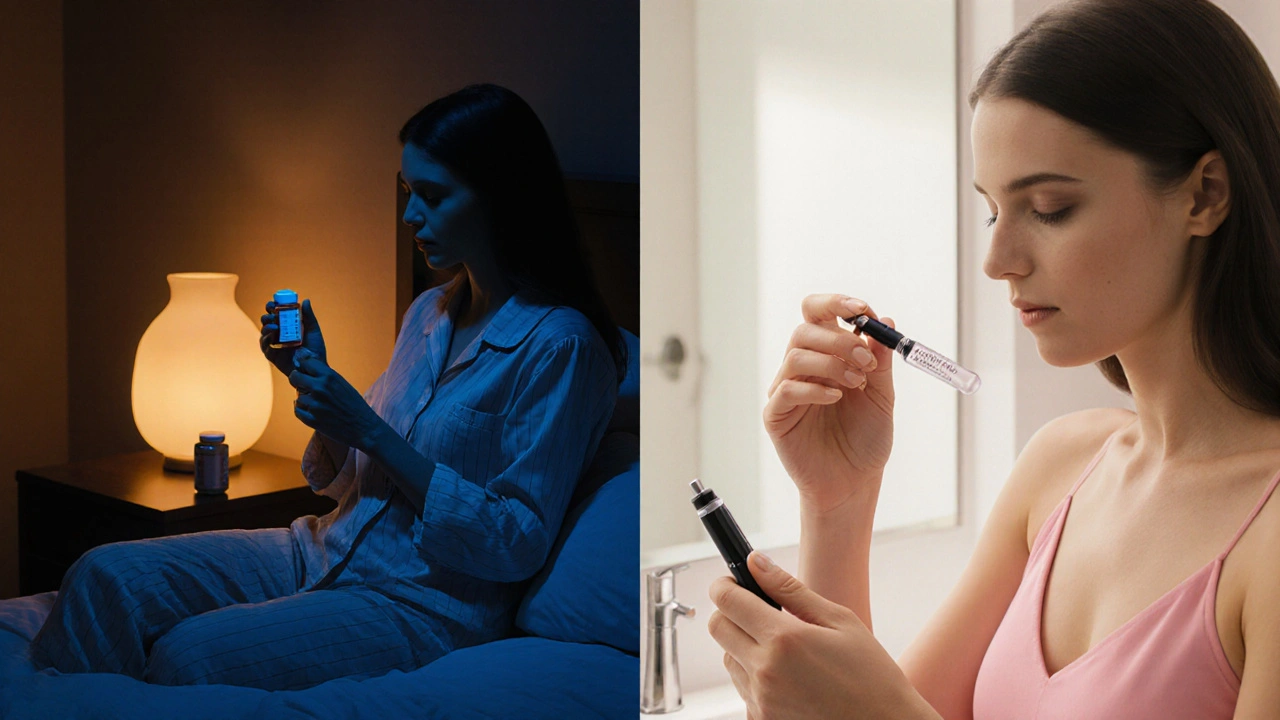Low Sexual Desire Treatment Selector
Find Your Best Treatment Option
Answer a few questions to get personalized recommendations for low sexual desire treatments. This tool considers your health status, preferences, and budget to help you choose the most appropriate option.
When it comes to treating low sexual desire, Flibanserin often gets the spotlight, but it’s far from the only option on the table. Women and clinicians alike ask: is it the right choice, or do other drugs, hormones, or non‑pharmacologic approaches offer better results or fewer side effects? This guide compares Flibanserin with the most common alternatives, breaking down how each works, who benefits, and what you should watch out for.
Key Takeaways
- Flibanserin is an oral serotonin modulator approved for pre‑menopausal women with HSDD; it requires daily dosing and may cause dizziness or low blood pressure.
- Bremelanotide is an injectable peptide approved for both pre‑ and post‑menopausal women; it’s taken only as needed before sexual activity.
- Testosterone therapy can boost desire but is off‑label for women in many countries and needs careful monitoring of hormone levels.
- Psychological and lifestyle interventions (CBT, exercise, diet) have no side‑effects and work well as first‑line or adjunct treatments.
- Choosing the right option depends on severity, health profile, cost, and personal preference for daily pills versus on‑demand injections or non‑drug strategies.
What Is Flibanserin?
Flibanserin is a serotonin‑modulating agent originally developed as an antidepressant. In 2015 the FDA approved it under the brand name Addyi for pre‑menopausal women diagnosed with Hypoactive Sexual Desire Disorder (HSDD). It works by increasing dopamine and norepinephrine while decreasing serotonin in the prefrontal cortex, aiming to shift the brain’s reward circuitry toward sexual interest.
Typical dosing is 100mg taken at bedtime. Clinical trials showed an average increase of about 0.5-1.0 points on the Female Sexual Function Index (FSFI) desire domain, which translates to modest improvements for many women. However, the drug carries safety warnings: it can cause hypotension, dizziness, and syncope, especially when combined with alcohol or certain antidepressants.
Cost is a major consideration. In the United States the average wholesale price hovers around $350‑$400 per month, while many European health systems have not reimbursed it, leaving patients to pay out‑of‑pocket.
Alternative #1: Bremelanotide (Vyleesi)
Bremelanotide is a synthetic peptide that activates melanocortin‑4 receptors in the brain, a pathway linked to sexual arousal. Unlike Flibanserin, it is taken as a sub‑cutaneous injection (1mg) about 45minutes before anticipated sexual activity.
Approved by the FDA in 2019 for both pre‑ and post‑menopausal women with HSDD, Bremelanotide produces a quicker onset of effect-often within an hour-making it an “on‑demand” option. Common side effects include nausea, flushing, and a temporary increase in blood pressure.
Pricing is higher per dose (roughly $150‑$200 for a two‑month supply) but the total monthly cost can be lower if the medication is used only occasionally.
Alternative #2: Testosterone Therapy
Testosterone therapy for women usually involves a low‑dose transdermal gel, patch, or sub‑cutaneous pellet. Although not FDA‑approved for female HSDD in the U.S., many clinicians prescribe it off‑label based on evidence that modest increases in testosterone can raise libido.
Key benefits include a steady improvement in desire and, for some women, enhanced energy and mood. Risks involve acne, voice deepening, lipid changes, and the need for regular hormone level monitoring to avoid supraphysiologic concentrations.
Costs vary widely: compounded gels can run $30‑$80 per month, while commercial preparations are pricier.

Alternative #3: Cognitive Behavioral Therapy (CBT) and Sex Therapy
Cognitive Behavioral Therapy (CBT) for sexual desire focuses on identifying negative thought patterns, relationship dynamics, and performance anxiety that suppress desire. Certified sex therapists often combine CBT with education about anatomy and communication skills.
Research from the International Society for the Study of Women’s Sexual Health (ISSWSH) shows that 8‑12 weekly sessions can increase desire scores by 1.5‑2.0 points on the FSFI, comparable to pharmaceutical options but without side effects.
Typical cost per session ranges from $100‑$200, though many insurance plans cover mental‑health visits.
Alternative #4: Lifestyle Modification
Lifestyle Modification includes regular aerobic exercise, balanced nutrition, adequate sleep, and stress‑reduction techniques (e.g., mindfulness, yoga). A 2022 systematic review found that women who engaged in at least 150minutes of moderate‑intensity exercise per week reported a 30% increase in sexual desire over a six‑month period.
These changes also improve cardiovascular health, mood, and body image-all factors that indirectly support a healthy libido.
Side‑By‑Side Comparison
| Attribute | Flibanserin | Bremelanotide | Testosterone (off‑label) | CBT / Sex Therapy | Lifestyle Changes |
|---|---|---|---|---|---|
| Mechanism | Serotonin modulator (↑ dopamine, ↑ norepinephrine) | Melanocortin‑4 receptor agonist | Androgen supplementation (↑ free testosterone) | Psychological restructuring, communication training | Exercise, nutrition, stress reduction |
| Route & Dosing | Oral, 100mg nightly | Sub‑cutaneous injection, 1mg as needed | Transdermal gel/patch, daily low dose | Weekly 45‑min sessions (8‑12 weeks) | Daily activity, ongoing |
| FDA Status | Approved for pre‑menopausal HSDD | Approved for pre‑ and post‑menopausal HSDD | Off‑label (not FDA‑approved) | Not a drug; covered as mental‑health service | Not a drug; self‑managed |
| Common Side Effects | Dizziness, hypotension, nausea | Nausea, flushing, transient BP rise | Acne, hirsutism, lipid changes | Emotional discomfort (temporary) | Minimal (possible soreness from exercise) |
| Typical Cost (US) | $350‑$400/month | $150‑$200 per two‑month supply | $30‑$120/month | $100‑$200 per session | Variable; gym membership $30‑$70/month |
How to Choose the Right Option
Think of the decision as a flowchart:
- Assess severity and health status. If you have moderate‑to‑severe HSDD and no contraindications (e.g., uncontrolled hypertension), a pharmacologic route may be justified.
- Evaluate preference for daily versus on‑demand. Women who dislike nightly pills often gravitate toward Bremelanotide’s as‑needed model.
- Consider comorbid conditions. Those with a history of cardiovascular disease should avoid Flibanserin’s hypotension risk and may look to CBT or lifestyle changes first.
- Review insurance coverage. Many health plans cover CBT and sex therapy, while they rarely reimburse Flibanserin or Bremelanotide.
- Trial period. Most clinicians suggest a 12‑week trial of any medication before judging effectiveness, paired with regular follow‑up labs for hormone‑based treatments.

Potential Pitfalls and How to Avoid Them
Placebo response rates in sexual desire trials can reach 20‑30%, so perceived improvement may not always reflect a true drug effect. To mitigate this, keep a daily desire diary and share it with your provider.
Alcohol interacts strongly with Flibanserin, increasing syncope risk. Set a rule: no alcohol on nights you plan to take the medication.
For testosterone, avoid self‑prescribing compounded creams without lab monitoring-unchecked dosing can lead to masculinizing side effects.
Real‑World Example
Emma, a 38‑year‑old marketing manager, tried Flibanserin for three months but stopped due to dizziness after a weekend party. She switched to bremelanotide, using it only before planned dates, which eliminated the dizziness and gave her a noticeable boost in desire. Simultaneously, she added a thrice‑weekly Pilates class, which helped her feel more confident in her body. After six months, Emma reported a 1.8‑point increase on the FSFI desire domain-higher than the average reported for Flibanserin alone.
Bottom Line
There’s no one‑size‑fits‑all answer for low sexual desire. Flibanserin offers a convenient nightly pill but carries hypotension warnings and price constraints. Bremelanotide provides on‑demand dosing with a different side‑effect profile. Testosterone can be powerful but demands careful hormone monitoring. Non‑pharmacologic routes-CBT, sex therapy, and lifestyle tweaks-are safe, often effective, and can supplement or replace drug therapy.
Start by discussing your goals, health history, and budget with a qualified practitioner. A short trial of one option, coupled with a desire journal, will quickly reveal what works for you.
Frequently Asked Questions
Can men take Flibanserin for low libido?
Flibanserin is only FDA‑approved for pre‑menopausal women with HSDD. While some off‑label studies have explored its use in men, the safety profile and dosing are not established, so it is not recommended.
How long does it take for Flibanserin to show results?
Clinical trials used a 12‑week treatment period before measuring change. Some women notice a subtle lift in desire around 4‑6 weeks, but full benefits typically emerge after three months of consistent nightly dosing.
Is bremelanotide safe for women with high blood pressure?
Bremelanotide can cause a temporary rise in systolic blood pressure (averaging 5-10mmHg). Women with uncontrolled hypertension should avoid it or use it only under close medical supervision.
Do I need a prescription for testosterone therapy?
Yes. Even when used off‑label for women, testosterone requires a prescription and regular blood work to ensure levels stay within the low‑range female reference.
Can lifestyle changes alone cure HSDD?
For many women, especially those whose low desire stems from stress, poor sleep, or low fitness, lifestyle modifications can significantly improve libido and may eliminate the need for medication. However, if hormonal or neurochemical factors dominate, additional treatment may be necessary.

All Comments
Sherine Mary October 13, 2025
I've read through the entire guide and can point out several inconsistencies that deserve attention. First, the claim that Flibanserin requires a 12‑week trial is accurate, yet the article fails to mention that many clinicians extend the observation period to 24 weeks before deeming a patient a non‑responder. Second, the comparison table lists “Cost (US)” but mixes wholesale price with patient out‑of‑pocket expenses, creating a misleading impression of affordability. Third, the discussion of testosterone therapy omits the need for baseline SHBG measurements, which are essential for interpreting serum levels in women. Fourth, the safety warnings for Bremelanotide are understated; the transient blood pressure rise can be clinically significant in patients with pre‑existing hypertension. Fifth, the lifestyle section implies that exercise alone can “cure” HSDD, which contradicts the meta‑analysis showing only modest effect sizes. Sixth, the article repeats the same side‑effect profile for Flibanserin and Bremelanotide in a way that blurs their distinct pharmacodynamics. Seventh, the FAQ incorrectly states that Flibanserin is “only FDA‑approved for pre‑menopausal women” without acknowledging the ongoing trials for post‑menopausal cohorts. Eighth, the narrative uses the term “cure” multiple times, which is scientifically inaccurate for a condition with multifactorial etiology. Ninth, the recommendation to keep a desire diary is sound, yet the guide does not provide an example template. Tenth, the citation of the International Society for the Study of Women’s Sexual Health lacks a specific year, making verification difficult. Eleventh, the cost comparison ignores insurance coverage nuances that can dramatically reduce out‑of‑pocket spend. Twelfth, the article suggests “no side‑effects” for lifestyle changes, ignoring potential over‑training injuries. Thirteenth, the language around “off‑label” use of testosterone downplays the regulatory risk. Fourteenth, the reference to “hypotension” as a side effect of Flibanserin should be qualified by its incidence rate, which is less than 2 % in controlled trials. Fifteenth, the claim that CBT improves desire scores by 1.5‑2.0 points is correct, yet the article does not disclose the control group effect size. Sixteenth, overall the guide would benefit from a more rigorous editorial review to align the presented data with the primary literature.
AARON KEYS October 14, 2025
The article does a solid job summarizing the main options for low sexual desire, especially the distinction between daily and on‑demand dosing. I appreciate the inclusion of cost ranges, as financial considerations often shape treatment decisions. The safety warnings for Flibanserin are clearly stated, which helps patients avoid alcohol interactions. Overall, it's a useful resource for anyone starting the conversation with their clinician.
Summer Medina October 15, 2025
Okay so first off this whole guide looks like it was thrown together by someone who never read a medical textbook it mixes up the terminology like “hypoactive sexual desire disorder” and “low libido” as if they’re interchangeable the dosage instructions for Flibanserin are wrong you can’t just pop a pill and expect miracles overnight the article says 12 weeks but many doctors actually wait up to 6 months before calling it a failure also the cost section is whack it lists $350‑$400 a month but most insurance plans actually cover part of it if you have a good PPO the part about bremelanotide being “on‑demand” is half‑right you need to inject it 45 minutes before sex not just whenever you feel like it and the side effects are downplayed the nausea and flushing can be pretty intense for some people the piece on testosterone therapy completely skips the need for baseline labs which is a big safety issue you can’t just start a hormone without checking liver enzymes and lipid panels the lifestyle tips are nice but they sound like a generic wellness blog you need at least 150 minutes of cardio a week not just “exercise” and the table formatting is messy the headings don’t line up the rows are off the grid overall the guide feels like a marketing flyer rather than a balanced medical review
Melissa Shore October 16, 2025
You raise several valid points about the need for clearer dosing timelines and insurance nuances. The guide could certainly benefit from a more detailed breakdown of coverage options. Adding a simple lab checklist for testosterone would improve safety guidance. Thanks for highlighting these gaps.
Michelle Pellin October 17, 2025
Behold, the labyrinthine landscape of desire‑enhancing therapies, wherein every pharmacologic ember flickers with hope and peril alike. Flibanserin, that nightly sentinel, whispers promises of dopamine’s gentle caress while demanding abstinence from even a modest wineglass. Bremelanotide, the daring inject‑and‑await, summons melanocortin gates with a fleeting prick, yet leaves one’s pulse racing like an untamed stallion. Testosterone, the sovereign hormone, crowns the body with vigor, albeit at the risk of unveiling a masquerade of masculinization. Cognitive therapy, the alchemical art of thought, reshapes the very scaffolding of yearning without a single pill. Lifestyle alchemy, the humble yet potent forge of exercise and mindfulness, steels the spirit for intimate communion. In this grand tableau, the clinician’s pen must script a personalized sonnet, balancing cost, conscience, and corporeal chemistry. Let the patient, armed with knowledge, choose the stanza that sings most true to their soul.
Keiber Marquez October 18, 2025
This just sounds like hype.
Lily Saeli October 19, 2025
We must confront the ethical dimensions of medicating desire, for the pursuit of pleasure cannot be divorced from the moral architecture of autonomy. To prescribe a serotonin modulator without addressing the relational undercurrents reduces intimacy to a chemical transaction. The article briefly mentions counseling, yet it treats therapy as an afterthought rather than a foundational pillar. True empowerment arises when individuals interrogate the societal narratives that stigmatize female sexuality. Only then can pharmacology serve as a true adjunct rather than a crutch. Ignoring this philosophical groundwork risks perpetuating a culture of dependency.
April Conley October 20, 2025
The cultural stigma you mention is precisely why clinicians must adopt a holistic lens. Ignoring relational dynamics is a disservice to patients seeking authentic connection. We should champion integrated care that marries medication with open dialogue. Your call for deeper philosophical engagement is spot on.
Sophie Rabey October 20, 2025
Wow, another “comprehensive” guide that conveniently omits the real-world adherence nightmare. The pharmacokinetic mumbo‑jumbo sounds impressive until you realize patients have to remember nightly pills or schedule injections around a calendar. The cost breakdown reads like a shopping list for a boutique pharmacy. And let’s not forget the “lifestyle changes” section – because everyone has the time and energy to hit the gym after a stressful day. In short, the piece is polished, but the practicality factor is seriously lacking.
Sean Powell October 21, 2025
Great points, Sophie. The guide could definitely benefit from a realistic discussion of adherence hurdles and financial strain. Adding patient testimonials would humanize the data and help readers see the practical side of each option. Also, a quick tip sheet on navigating insurance claims might bridge the gap between theory and practice. Thanks for raising these crucial considerations.
Isha Khullar October 22, 2025
It is a profound injustice that society continues to silence women’s sexual agency under the guise of “medicalization.” By packaging desire as a disorder to be fixed, we ignore the deeper cultural narratives that deem female pleasure optional. The article’s neutral tone masks this systemic bias, presenting pharmaceuticals as the panacea while sidelining empowerment. We must demand that clinicians address the root causes – patriarchy, shame, and unrealistic expectations – before prescribing a pill. Only then can treatment be truly holistic and just. The moral imperative is clear: prioritize consent, education, and self‑determination above profit‑driven drug promotion.
jeff lamore October 23, 2025
I commend your emphasis on ethical considerations and the need for broader cultural change. While the guide focuses on therapeutic options, integrating sociocultural context would indeed enrich its scope. Providing references to feminist health literature could offer readers additional perspectives. Your call for a more nuanced approach is well taken.
Kris cree9 October 24, 2025
Seriously, this article feels like it was written by a marketing team with a hidden agenda. All the hype about “new breakthroughs” just distracts from the fact that many women end up spending hundreds on drugs that barely work. The so‑called “on‑demand” injection is a gimmick, and the lifestyle tips are barely more than generic wellness fluff. We need honest, no‑spin information that tells us the truth about risks and benefits. Otherwise we’re just fueling the pharma machine.
Ian McKay October 25, 2025
Your critique highlights important shortcomings in the presentation of the data. It would be beneficial for future revisions to include clearer citations and balanced risk assessments. Adding a concise summary table could also improve readability. Thank you for your thoughtful analysis.